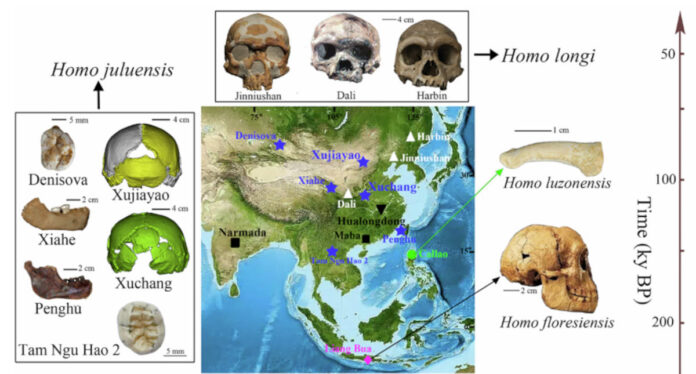A team of scientists specializing in hominin fossils and human evolution in China and East Asia have announced the discovery of a new human ancestor dating back to the Late Quaternary or Middle Pleistocene era, approximately 300,000 years ago. This newly identified species is named Homo juluensis, signifying its large size ( ju lu means “huge head” in Chinese).
The evidence for this discovery comes from fossils unearthed in the 1970s at the Xujiayao archaeological site in China, located on the border of Hebei and Shanxi provinces in northern China. A fresh analysis of these fossils led to the identification of the new species, although further research is required to solidify the existence of Homo juluensis.
Bone fragments from multiple individuals at the Xujiayao site in China challenge existing assumptions about the region’s fossil history. (Wu Xiujie/Nature)
Implications of a New Human Ancestor
The unearthed remains of 16 individuals at the Xujiayao site, along with a significant collection of stone tools and animal bones, are dated to a period between 200,000 and 160,000 years ago, during a glacial period of lower global temperatures.
In a publication in the journal Nature Communications, Christopher Bae and Xiujie Wu present compelling evidence that this fossil collection represents a previously unrecognized archaic human species.
During the Middle and Late Pleistocene eras, several archaic human species inhabited Eurasia, including eastern Asia (China, Japan, Korea, and nearby countries). Bae and Wu argue that a new categorization and analysis of the fossil record enabled them to unveil this significant discovery.
“This study elucidates the hominin fossil record, which often overlooks specimens not easily classified as Homo erectus, Homo neanderthalensis, or Homo sapiens,” Bae stated in a University of Hawaii press release.
“Although we embarked on this project years ago, the identification of a new hominin species and the organization of Asian hominin fossils into distinct groups exceeded our expectations. This will undoubtedly aid in scientific communication.”

Homo juluensis (blue five-pointed stars) encompasses Xujiayao, Xuchang, Xiahe, Penghu, Denisova, and Tam Ngu Hao 2; Homo longi (white triangles) comprises Harbin, Dali, and Jinniushan; Homo floresiensis (pink diamond) includes Liang Bua; Homo luzonensis (green circle) encompasses Callao. While Hualongdong (black inverted triangle) was initially grouped with the H. longi fossils, it is maintained separately for further investigation. Maba and Narmada (black squares) have been considered as a single population in many studies; more analysis may result in their inclusion within the broader H. neanderthalensis species or a new taxonomic classification. The accompanying Box provides descriptive information on the type specimens and sites for the four discussed hominin species: H. floresiensis; H. luzonensis; H. longi; H. juluensis. (Bae & Wu/Nature)
Upon closer examination of the ancient fossils, Bae and Wu were intrigued by their significant size. These hominin skulls measured between 103 and 109 cubic inches (1,700 and 1,800 cubic centimeters) in volume, surpassing the average of about 81 cubic inches (1,350 cubic centimeters) for ancient Homo sapiens skulls. Even Neanderthals fell short of Homo juluensis, with an average skull volume of 88 cubic inches (1,450 cubic centimeters).
Although not colossal, Homo juluensis’ size sets it distinctly apart from modern humans.
“This discrepancy between modern Homo sapiens, Neanderthals, and this proposed new species is substantial,” Bae remarked in an interview with the South China Morning Post.
“The eastern Asian fossil record underscores the complexity of human evolution, compelling us to revise and reassess various evolutionary models in line with the expanding fossil evidence.”

The nine Xujiayao teeth fossils analyzed in the study. (Bae & Wu/Nature)
Rethinking the Denisovans
Bae and Wu suggest a bold theory regarding the origins of the Denisovans. These enigmatic human ancestors were only identified in 2008 following the discovery of scattered fossils in the Denisovan Cave in Siberia’s Altai Mountains.
Like Homo juluensis, the Denisovans possessed distinctive teeth, differing from Neanderthals and Homo sapiens. This dental similarity aligns them more closely with Homo juluensis, as proposed by Bae and Wu.
“Denisovan molars were notably large. The molars discovered at Xujiayao in our principal specimen exhibit similar characteristics,” Bae explained, suggesting the correlation is not coincidental.
Upon comparing the teeth biting surfaces of Denisovans with those at Xujiayao, Bae and Wu found them to be nearly identical.
Based on this observation and the delayed recognition of Denisovans, the researchers propose that Denisovans were actually a population of Homo juluensis rather than a distinct hominin species.
This claim is likely to spark debate, as the scientific community has generally acknowledged Denisovans as a separate human ancestor. Nevertheless, if the existence of Homo juluensis is confirmed by other experts, it could potentially alter the official status of Denisovans.
Possible Human Ancestors Yet to Be Discovered
Through an analysis of stone tools and animal bones from the Xujiayao site, the researchers reconstructed the lifestyle of Homo juluensis in that specific location.
These hominins heavily relied on wild horses, hunting, butchering, and consuming them, including their meat, cartilage, and bone marrow. The horses’ skins were likely used for clothing to endure the severe winter conditions during the glacial period they inhabited. Due to surviving in harsh climates, Homo juluensis probably lived in small groups with a minimal total population, explaining the previous absence of their fossils.
Bae and Wu estimate the species went extinct around 120,000 years ago, coinciding with the initial Homo sapiens migrations into modern-day China. Despite extinction, some Homo juluensis DNA likely persisted through interbreeding with humans, potentially explaining the detected Denisovan DNA in the human genome.
“Ongoing research in China and broader eastern Asia indicates the coexistence of multiple hominin lineages during the Late Quaternary,” the researchers noted in their Nature Communications article. Between 300,000 and 50,000 years ago, this region witnessed a substantial hominin presence, suggesting the possibility of undiscovered hominin species.
Top image: Reorganized hominin fossils from East Asia following the uncovering of a new species. Source: Bae & Wu/Nature
By Nathan Falde




